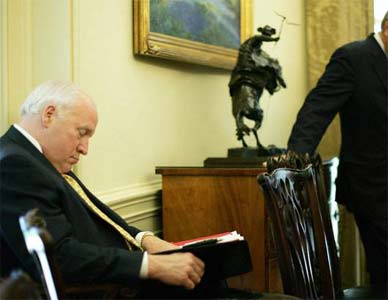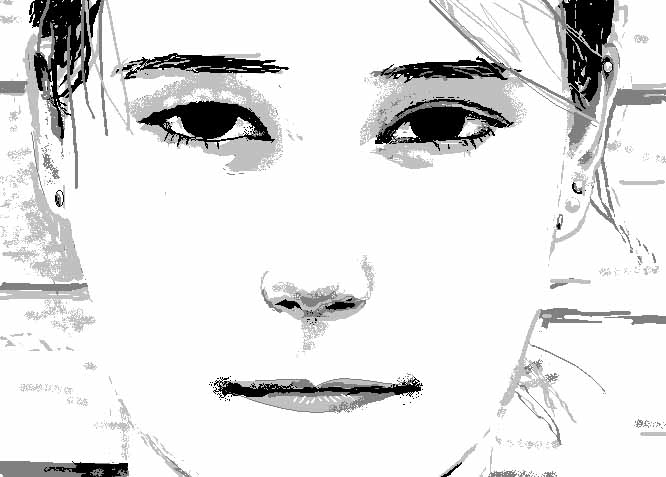View current page
...more recent posts
Not a big fan of Joseph Cornell's boxes--too much about the romance of old stuff scrounged in swap meets, too in love with their own delicacy, too frequently visually inert--but he deserves his place in history as the Father of the Remix. From Senses of Cinema:
Rose Hobart (1936) consists almost entirely of footage taken from East of Borneo, a 1931 jungle B-film starring the nearly forgotten actress Rose Hobart. Cornell condensed the 77-minute feature into a 20-minute short, removing virtually every shot that didn't feature Hobart, as well as all of the action sequences. In so doing, he utterly transforms the images, stripping away the awkward construction and stilted drama of the original to reveal the wonderful sense of mystery that saturates the greatest early genre films.Yes! That sequence is amazing, I wish it was in this Quicktime clip from the Walker Art Center. The Cornells of today are lurking on YouTube and/or being busted by the intellectual property police. Too damn bad.
While East of Borneo is a sound film, Rose Hobart must be projected at silent speed, accompanied by a tape of "Forte Allegre" and "Belem Bayonne" from Nestor Amaral's Holiday in Brazil, a kitschy record Cornell found in a Manhattan junk store. As a result, the characters move with a peculiar, lugubrious lassitude, as if mired deep in a dream. In addition, the film should be projected through a deep blue filter, unless the print is already tinted blue. The rich blue tint it imparts is the same hue universally used in the silent era to signify night.
Rose Hobart was only one of several mythologized actresses who populated Cornell's hermetic world. Many of his boxes were homages to the actresses that formed his pantheon: Lauren Bacall, Hedy Lamarr, Greta Garbo and Deanna Durbin, among others. (Yawn. --tm) In Rose Hobart, Cornell holds Hobart in a state of semi-suspension, turning the film itself into a sort of box. She moves her hands, shifts her gaze, gestures briefly, smiles enigmatically, perhaps steps slightly to the side, and little more. The world appears as a sort of strange theatre, staged for her alone.
But the root of Cornell's genius as a filmmaker is his singular version of montage. Cornell's version of continuity is the continuity of the dream. He does not juxtapose images so much as suggest unlikely — but still vaguely plausible — connections between them. Hobart's clothing may change suddenly between shots, but her gesture is continued or she remains at a similar point in the frame. Unlike most collage filmmakers, Cornell does not rely on cheap irony or non sequitur. His films are unsettling because their inexplicable strings of images are like reflections from the deep well of the subconscious. In fact, one of the most arresting images in Rose Hobart comes when a solar or lunar eclipse is paired with the image of an object falling into a circular pool of water. Hobart simply gazes bemusedly at this spectacle, as if it were little more than a parlour trick.
"Spring Loaded" [2.1 MB .mp3]
This got recalled to the factory, but it's back with a few more notes and a more forgiving structure. It's still pretty goofy. Sorry to Bill, who's excellent comment got wiped when I panicked and yanked the piece. (He said: "I was waiting for the spring break so I could get loaded.") This is another Sidstation and analog drum machine piece, but the most incisive lead sounds are a Kontakt2 synth with phasing and other filter effects.
Update: snipped out a couple of bars of the "main theme" towards the end.

Vice President Cheney during Chinese President Hu's press conference. The Veep's staff says he was "studying his notes," but it's pretty clear he's sawing logs. Oh, well, at least he's not shooting anyone.
This is what he's going to look like in a few years, retired to his 3 million dollar residence on Maryland's Eastern Shore. Just an amiable old duffer, nodding off on his front porch, remembering all the good times from his years of invading countries, ordering "swirlies" for prisoners in Gitmo, and enhancing the Halliburton bottom line. Unless he gets some Pinochet action late in life, heh heh.
YouTube: Frank Zappa, "Pound for a Brown," orchestral version. This is one of the prettiest tunes FZ wrote--originally from Uncle Meat ("A Pound for a Brown on the Bus"). It's nice to see it getting this treatment, even though Zappa thought the classical music consumption/production system was basically ludicrous.

Via MTAA comes the news that Harlem gallery Triple Candie is doing a Cady Noland survey show, consisting of re-creations of her past artworks based on the Internet and other documentary sources. The re-creations are not approved by Noland, who "dropped out" of the art world in the mid '90s but "tightly controls" her work; this is not to say she disapproves--according to the press release she simply "was not consulted or notified."
Noland is a proto-slacker, neo-scatter artist whose themes are consumerism, nihilism, and politics as refracted through tabloid media; she achieved instant notoriety in the late '80s/early '90s with installations of beer cans, machine parts, and other urban or post-industrial detritus. Triple Candie sees her as an influence on a large range of current artists, including Wade Guyton, Sarah Lucas, and Banks Violette.
I'm curious what Noland's reaction to this will be. The press release says she "haunts the art world like a ghost" while scrupulously limiting the exhibition and publication of her work. This project is kind of fascinating coming so soon after Jack Pierson pitched a fit over the sign letter sculptures at Barneys that resemble his conceptualist/assemblage works. Pierson followed Noland in the art world's every-couple-of-years "new car rollout" hype cycle (both showed at the influential American Fine Arts gallery), but he stayed in the game and became a successful market entity. Does she care that Triple Candie is doing this? Would she have the clout or stamina to stop faithful re-creations of her work (as opposed to a mere window-dresser's homage)?
And finally, doesn't Elaine Sturtevant's inclusion in the current Whitney Biennial, showing exacting Duchamp knockoffs, legitimize this project (and delegitimize Pierson's huffing and puffing)? Some interesting questions here.
GIF Shows
 The solo show I'm doing next month is titled "Room Sized Animated GIFs." The ArtCal listing is here (thanks to ArtCal--the listing is in RSS now will go "live" a week before the opening). The choice to use, in the title, a banal everyday computer "file extension" (.GIF) that hasn't quite risen to the level of a household word was deliberate. The point is not to be tech-elitist but rather that there is nothing more un-elite than an animated GIF, your grandmother has several of them on her homepage, but the word "GIF" is nevertheless seldom bandied about in the medieval, still-painting-centric artworld.
The solo show I'm doing next month is titled "Room Sized Animated GIFs." The ArtCal listing is here (thanks to ArtCal--the listing is in RSS now will go "live" a week before the opening). The choice to use, in the title, a banal everyday computer "file extension" (.GIF) that hasn't quite risen to the level of a household word was deliberate. The point is not to be tech-elitist but rather that there is nothing more un-elite than an animated GIF, your grandmother has several of them on her homepage, but the word "GIF" is nevertheless seldom bandied about in the medieval, still-painting-centric artworld. Another show I'm in taking the humble GIF as its theme is described on Marisa Olson's blog:
Hi, there. I've unashamedly followed the masses to Myspace, and there I've erected a page for an upcoming exhibit I'm curating. Please check it out and become our friend:Why GIFs? They're a relatively "open source" way to get ideas, in the form of moving images, out to broad audience. They are low or no cost to make, consume very little bandwidth, no one has to buy or download a proprietary player to play them. They have their own special charm, minimal in the way garage rock is minimal. Scaling them up to room size, showing them on TV screens as opposed to computer monitors, exhibiting individual frames in a grid, are ways to inject this aesthetic into physical space, which has its own demands, limitations, and pleasures.
http://www.myspace.com/gifshow
The show is called The Gif Show (I briefly considered Meet the Giffords, Meet the Giffordz, Gif Starz, and Choosy Moms Choose GIF). It opens May 3, at San Francisco's beloved RX Gallery, and is co-presented by Rhizome. The artists are Cory Arcangel, Peter Baldes, Michael Bell-Smith, Jimpunk, Olia Lialina, Abe Linkoln, Guthrie Lonergan, Lovid, Tom Moody, Paper Rad, Paul Slocum, and Matt Smear (aka 893/umeancompetitor). Everyone's showing GIFs, and some are also showing videos, works on paper, sound, and other cool related stuff. Together, their work shows the diversity of forms to be found in GIFs, and many of them comment on the broader social life of these image files.
Hence the Myspace page... GIFs grow, breed, and comingle sparklingly on Myspace. Please come be our neighbor, there, and help us spread the word about the show. (More curatorial & opening party details to come, here, in a bit.)
posted by Marisa S. Olson at 12:01
More YouTubin'--it's weird, I hate TV but I can watch these little blurry things all day.
Can "Paperhouse" live 1970 - awesome - Czukay and Suzuki: "no shirt no service" (also here--louder sound, worse video, loads slower).
"Mushroom"--probably my favorite Can song--suspect the video was made later than 1970.
Boards of Canada "Gyroscope" (for the video) - lots of geometric patterns and mismatched letters - watch out, Jack Pierson's gallery will write you an angry note.
Boards of Canada "In a Beautiful Place" (for the music).
Atari Teenage Riot - "Revolution Action" - ahh, the dotcom era.
Clipse "Grindin" --that '80s beatbox sound will never die. [link replaced Aug 2010]
808 State "Pacific" (1989) - the sublime.
Aphex Twin "Come to Daddy" - the ridiculous. I remember James saying in an interview he woke up and his girlfriend was in the bed next to him wearing one of those masks and he freaked out.
Roxy Music "Do the Strand" (The '80s were invented in 1973--and see Eno in "outre" drag).
Roxy Music "In Every Dream Home a Heartache" (Eno wearing that feathery thing--with VCS3 and tapes on stage).
King Crimson "Lark's Tongues in Aspic" 1972 (feat. Jamie Muir, who was in the Music Improvisation Company with the late Derek Bailey. Troll repellent: yes, it's "pretentious").
Update, Aug. 2010: All these links are dead except Mushroom, Boards of Canada, and Clipse. Viacom - what a joke.
